Changes in vehicle design have created some interesting challenges in the collision repair industry, such as finding the proper repair procedure for the specific vehicle being repaired. Another challenge is making sure the technician follows that procedure.
With the introduction of high-strength steels, we had to start reexamining the “old” ways of doing things. Are the old ways still applicable with the new, stronger steels and the automakers’ increasing use of them to where they’re comprising a larger percentage of the metals used in vehicles? The old ways may become obsolete very quickly.
Straightening
Yet another challenge these advanced metals present is straightening. The vehicle manufacturers’ procedures and I-CAR’s SPS07 class show us how strong these parts are and how heat affects their strength.
A major concern for any technician repairing vehicles with these high-strength steels is collateral damage, or the damage to parts not damaged by the collision but by the repair process. Some damage may be unavoidable during the repair. Damage also may be due to technician error in planning. When extremely strong steels are being straightened or a vehicle is being pulled to correct dimensions, anchoring points or adjoining parts may be damaged from the force required to straighten the damaged parts. In many cases, this collateral damage may be avoided through proper planning.
Stronger Steels
The steels being used today are much stronger. With this strength, there has been a change in the brittleness of the steel. The stronger the steel, the more brittle and prone to cracking it is during collision and the repair process. This could make for dangerous snapping of parts while on a frame rack. The practice of using safety chains or cables while pulling is something few shops practice.
A common practice to make steel more pliable and easier to work with is to apply heat. This practice used for straightening frame rails has saved many vehicles from the salvage cycle. With high-strength steels, this may not be a recommended procedure on metal that is not to be replaced. Heat may damage the steel strength and possibly produce a disastrous effect if the vehicle were to be involved in another crash.
The procedure of “cold straightening” or not using heat is becoming the norm on many frame rails and reinforcements. In this procedure, heat is used in the repair but it may be limited in temperature and/or time heated.
The statement “cold straighten only” requires that if heat was or is applied, the part must be replaced. This would include steels not intentionally heated during repairs. Looking up welding and repair procedures is critical in today’s repair industry. Reference car manufacturer websites for heat recommendations. Also, take a look at I-CAR classes DAM08, SPS07, SPS01, SPS02, SPS09, GEN03, FOR05, TOY01, HON01, WCS04 and the new SPS10 this year.
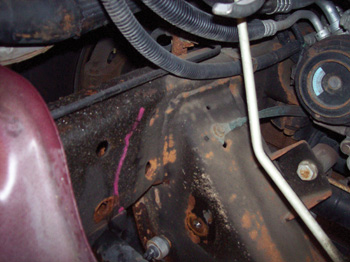 “/>Replacement
“/>Replacement
What if the steel in question was not to be part of the repair but be replaced? May heat be used then? The answer is yes and no. Confusing, but true. Heat may be used, but it must be used in a controlled fashion. This means the Heat Affect Zone (HAZ) needs to be addressed.
Heat from sources may be hard to regulate or control. This heat would radiate out and possibly damage surrounding parts. A technician needs to address these concerns before applying heat of any kind to straighten steel, including:
Is it recommended?: Looking up the information on manufacturer websites or ALLDATA, CCC, Audatex or Mitchell is a good place to start. If heat is allowed, how much and how long must be addressed.
Adhesives: Are there any adhesives in the area that could be damaged or catch fire?
Foams: Are there any foams in the area that could be damaged or start on fire?
Corrosion protection: Will the technician destroy the corrosion protection in the area heat is to be applied? The area must be accessible to reapply corrosion protection if damaged.
Monitoring HAZ: Temperature crayons and paints or a non-contact thermometer should be used to not allow heat to radiate into parts that are not to be replaced.
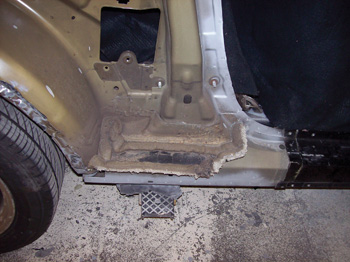 “/>Applying Heat
“/>Applying Heat
Applying heat to damaged parts can be done in numerous ways. The two most common are open flame via an oxyacetylene torch or even propane, and induction heating. Each has advantages and disadvantages.
Oxyacetylene is a cheap and fast way to produce heat, and is fairly portable and familiar to most technicians. One of the drawbacks is that heat from the torch is applied to the surface, and the heat must radiate into the steel to allow for movement. This same heat also radiates outward at a rapid rate, which can be difficult to control and could heat outside the area desired. It could have some damaging effects on surrounding parts. The open flame also raises concern for fires and injuries.
Induction heaters are not necessarily new, but less familiar to technicians. An induction heater uses an RF or magnetic field to create heat. Due to the heat radiating from within the metal and the magnetic field being very narrowly focused, it’s easier for technicians to control the heat. The magnetic field may also be moved to create a larger HAZ if needed.
The time it takes for an induction heater to heat the metal is considerably short, which helps limit the damage that could be caused by heat radiating outward. Many machines can achieve up to 1,300° F in seconds. With a non-contact thermometer, a technician can control the HAZ fairly easy. Once the metal is softened, the collateral damage or stresses on undamaged parts or anchor points of the vehicle are dramatically reduced. The speed and control make this an easy process for shops.
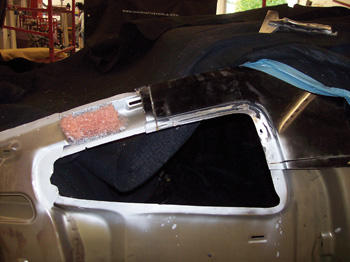 “/>Other Uses
“/>Other Uses
Induction heaters also have other uses that make them valuable tools. One is loosening or working with rusted or seized fasteners. Unlike a torch, induction heaters can be focused just to a nut or fastener without heating surrounding parts. They can also remove moldings or emblems.
As with any tools, there are some cautions. When removing an emblem or molding, be conscious of what’s on the other side. Flutter foams in doors or adhesives will release on both sides of the heated surface.
Many induction heaters can remove glass as well. The coil is used on the outside of the glass, and the magnetic field travels through the non-metallic glass and heats the pinchweld. This heat releases the bond of either the primer, paint or urethane, whichever releases first. When removing glass from a salvage vehicle or from a total loss, the procedure is pretty straightforward. When doing an R&I of glass, there are some precautions technicians need to be aware of.
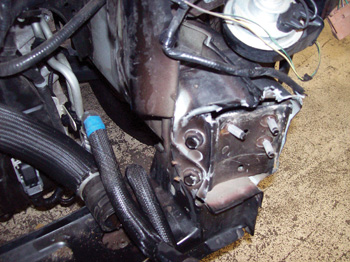 “/>Glass R & I
“/>Glass R & I
Why is glass to be R&I’d? If for the replacement of sheet metal, such as quarter panels and roofs, induction heaters are an excellent choice. For panels not to be replaced, we need to look at other issues:
- Heat applied to the steels. Will the tool create too much heat and damage high-strength steels? Is there ultra high-strength steel reinforcements welded into the zone?
- Will heat damage these welds?
- Will other adhesives not to be removed be affected?
- Is the paint original?
- Is the roof or panels attached to the steel aluminum or magnesium?
These questions must be addressed before using any type of tool that creates heat. Glass may be removed to replace the roof, but will the reinforcements welded in the HAZ be compromised? Are the quarter panels to be removed? If quarter panels are to remain, will heat affect these steels?
Many vehicles are manufactured using weld bonding, or squeeze type resistance spot welds with adhesive. The adhesive adds to vehicle rigidity and is a major part of corrosion protection. When the glass adhesive, body primer or paint releases from the heat generated, so does the adhesive on the other side of the pinchweld. Once this adhesive is released, the integrity of the vehicle may be compromised directly or indirectly. While removing a windshield, a roof panel that’s adhesively bonded would also be removed. This might not be the desired outcome.
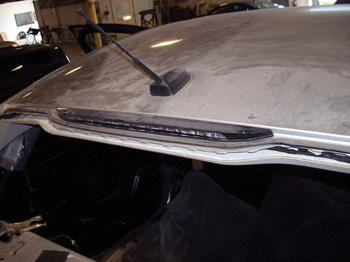 for painting.
for painting.
“/>Primers and paints might also be affected by heat. If a technician isn’t watching closely, the paint may blister. If the paint doesn’t blister and the glass is removed, the primer or paint may be still on urethane that’s still on the glass. Compromising the primer and paint would require the pinchweld to be completely sanded to bare metal and primed with an epoxy primer. Follow manufacturer guidelines as to proper procedures for pinchwelds regarding glass. The material is also covered in I-CAR’s GLA02 course. Failure to follow the correct procedures could cause possible leaks or failure to hold the glass in the vehicle.
Proper Training
As with any tool or procedure, a technician properly trained or educated on proper repair procedures and considerations will have consistent quality repairs. Failure to recognize the proper use of tools and failure to follow proper procedures can cost time, labor and customers…none of which any of us can afford.
Mitch Becker is a technical instructor for ABRA Auto Body & Glass. Contact him at (763) 585-6411 or [email protected].
I nduction Heaters: Multi-Use Tools
nduction Heaters: Multi-Use Tools
Steve Gough more than anybody knows the value of induction heating on today’s advanced materials. As vice president of Induction Innovations, he has seen firsthand the benefits of going flameless when straightening.
“As far as the advanced metals, you have to watch the temperature you get up to because, if you heat it up too much, you’re going to change the molecular structure of the metal,” says Gough. “That’s why it’s even more important to reference the manufacturers’ recommendations.”
Induction heating is much safer than using an oxyacetylene torch, says Gough, for a variety of reasons. But he also understands why some in the industry won’t let torches go.
“There are definitely some old-timers out there who have been using a torch long enough that they’ve perfected it, but it’s not a perfect tool,” he says. “You can heat other things nearby and you can start fires. There was one shop in California that lost their shop several years ago to a fire that was started by a torch. Several months later, they heard about our product and they were kicking themselves in the butt.”
Gough says shops that ditch the torch can also benefit from saving 15 percent or more on their insurance premiums.
Another benefit to induction heating is the many applications beyond the safe straightening of advanced metals that it offers. Examples include the removal of adhesively bonded parts, paintless dent repair (as long as there isn’t a crease in the metal) and the removal of rusted nuts and bolts.
“You can literally heat up a nut right next to a fuel line because that field goes to the nut that’s inside the coil,” Gough says. “We can heat up a 3/4-inch nut cherry red in about 15 seconds. With bolts, it’s a different procedure in that once you heat them up, they expand and then you have to wait about 15 minutes for them to cool back down. Then, you can zip them right out.”
Induction heating also eliminates the use of chemicals that are bad for the environment. For example, with side molding, you would traditionally rip it off and then soak it in chemicals to remove the foam backing.
“What do you do with the chemicals when you’re done?” Gough asks. “Our method doesn’t use chemicals. It takes off the foam backing with the molding, leaving the sheet metal clean.”
So why hasn’t every single shop caught on to the multi-use advantages of induction heating? Gough has a few theories.
“The OEM repair procedures are still being discovered and acknowledged,” he says. “The OEMs cannot tell you every way on how to fix their own vehicles, but they will approve some of the best ways that shops are doing it, so they’re still looking into a lot of that and we’re working with them now to do that. How do we reach out to people? There isn’t necessarily one simple answer on how to change it all, other than to just start talking about it more.”













